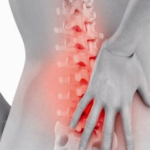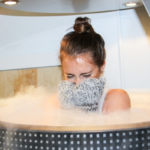Running with a hernia in the lumbar spine
Many patients who are allowed physical activity are wondering if it is possible to run with lumbar hernias? After all, a hernial protrusion in the spinal column is a very serious disease, which in some cases can lead to disability. Today, doctors still cannot accurately answer this question.
Is active sports allowed
Active sports are a good help in the fight against various diseases of the musculoskeletal system. However, will they be useful for hernial protrusion?
Today, from different doctors you can hear different recommendations regarding sports activities such as running.
In favor of such activities is the fact that the load stimulates many positive processes in the spinal column. In this regard, blood circulation improves, regeneration starts, the spine receives more nutrients and recovers faster.
On the other hand, as doctors say, it is impossible not to take into account the pathogenetic features of the formation of hernias. The nucleus pulposus of the intervertebral disc, which is no longer surrounded by a special fibrous sheath, is easily traumatized, and can also injure the surrounding tissues. This happens most often with careless and sudden movements, which are not always possible to avoid while running.
As a result, doctors often draw the attention of patients to the fact that the load should be very strictly dosed. This means that an overload of the spine is not allowed, since due to a defect, it will still not be able to cope with it.
Running with an intervertebral hernia of the lumbar is a useful activity, but only if the patient follows the simple rules of training.
Rules to follow
To decide whether a person can run with a herniated lumbar spine, you need to make sure that he can carefully follow simple rules.
These include:
- refusal of movements that cause severe discomfort or entail pronounced pain (pain indicates that the affected spinal region cannot cope with the chosen intensity of the load and, as a result, such exercises cease to be beneficial, bringing mainly harm);
- the first classes should be held under the supervision of a trainer, since only a specialist will be able to see if the patient performs the movements correctly and, if anything, correct them (the trainer should also be informed of the appearance of discomfort or pain so that he can correct the technique of performing the exercise or, if necessary, , replace it with something else);
- any exercises that twist the spine on the run or in a static state are strictly prohibited (twisting can lead to an exacerbation of the disease, since the defect will be pinched);
- if a treadmill is chosen to perform the exercises, it is strictly forbidden to set it up at a high speed immediately (the increase in the pace and amplitude of movements should occur gradually, and if at some point the patient feels pain, it is better to go back a few steps and perform less intense loads) ;
- osteochondrosis - a disease that greatly limits the duration of any physical activity (strain of the spine in this case is even more dangerous than with a simple hernia without complications);
- with osteochondrosis, patients are often advised to either choose short routes , or divide one long interval into several small ones, so that it is possible to give the body a rest at a distance;
- jogging will have to be abandoned if the patient is forced to take pain medications (these drugs limit sensitivity to pain, because of which a person may feel that something is wrong with his back much later than it should be, when the harm has already been done);
- if the patient has any severe defects of the spinal column or its curvature, jogging is also prohibited for him , since any defect increases the load on the spinal column.
If the hernia is in the acute stage, walking, like jogging, is strictly prohibited. During this period, rest is recommended, and any physical activity can be resumed only after the permission of the doctor.
Preparing for a run
Can I run with a herniated disc? In theory, yes, but only in the case when the disease was driven into a period of stable remission. At the same time, you will have to prepare for such an active load so as not to aggravate your health condition. Before running, it is also obligatory to consult a doctor who will assess the patient's condition and give his permission.
It is strictly forbidden to start running immediately. Before any run, the body must undergo minimal training in order to adapt to a more intense load.
As a preparation, you can use:
- a simple set of exercises from the complex for the treatment of lumbar hernia;
- simple yoga asanas;
- Pilates classes, if possible.
Such a warm-up will help the muscles and bones prepare for the upcoming loads. Also, the warm-up will consolidate the results that the patient can achieve while running.
Without preliminary preparation, running is not only not useful, but also poses a danger to the patient. This is due to the fact that the nucleus pulposus, which has formed a hernia, is subject to mechanical stress and may simply not be able to cope with the load that they are trying to impose on it.
It is recommended to prepare the body not only before running, but also before Nordic or any other sports walking.
Contraindications
The lower back is a part of the spine, which is very susceptible to a wide variety of negative influences. This part of the back is rightfully considered the most vulnerable, but at the same time, it is on it that the main loads fall due to upright posture.
The lumbar region is always very sensitive to any physical activity. Especially dangerous are various fast movements that lead to pinching of hernial protrusions, and sometimes to compression of the nerves located in the spinal canal.
In some cases, the lumbar spine becomes even more vulnerable to adverse factors.
This happens when:
- jump in body temperature;
- various viral or infectious pathologies that occur in an active form;
- exacerbation of the vertebral protrusion, which is usually accompanied by acute pain syndrome;
- the presence of malignant tumors in various parts of the body;
- severe chronic diseases affecting the gastrointestinal tract, heart, brain, bronchopulmonary system.
The presence of any of the adverse factors that can reduce the body's resistance is a strict contraindication for running or other types of exercise therapy.
If contraindications are neglected, this can adversely affect not only the defect of the intervertebral space, but also the general health of the patient. To exclude the presence of contraindications, it is also recommended to consult a doctor.
The right tactics are the basis of security
Intervertebral hernia is a complex and dangerous disease. In order for running to be not only effective, but also not to harm the patient, you will have to choose the right training tactics. There are four main recommendations.
It is necessary to avoid strong shaking and swinging of the body during classes. This can be achieved by placing the feet parallel with each step. In this case, the stop angle should be minimal when running in one line.
In order for the load to be even, it is necessary to run in such a way as to land with each next step not on the heel or toe, but on the entire foot as a whole. This will help to minimize the load, and also protect the spine from overexertion.
The duration of the run, speed and its amplitude must be selected based on individual characteristics and endurance. If endurance is still poorly developed, you will have to give up long and fast runs.
While running, you will have to carefully maintain the correct posture. This is necessary to avoid rupture of the nucleus pulposus or abrupt clamping of the vascular bundles. Too much deflection of the body forward or backward is not allowed.
Unsupervised classes without prior consultations are unacceptable.
Other permitted loads
Running with a hernia of the lumbar spine is not the only permitted physical activity. During an exacerbation, for example, active movements are generally prohibited, only light physical activity is allowed, which is performed right in bed so as not to overload the spinal column.
When it was possible to bring the hernia into remission, patients are allowed to engage in physiotherapy exercises, yoga, Pilates, and gymnastics. These loads are simpler than those that a person faces when running. That is why it is recommended to start preparing for more vigorous activity with them.
Patients with hernias in the lumbar region are strictly prohibited from power sports.
This means that classes with dumbbells and a barbell will have to be excluded. Power load can provoke an exacerbation of the hernia, which will significantly worsen the patient's condition.
Running is a useful form of physical activity for a herniated lumbar spine. The main thing to remember is the rules for conducting classes. If the patient has consulted a doctor and follows all the basic recommendations, jogging will improve his health and have a beneficial effect on the hernial defect. However, it is important to remember that, like any other activity, it can be not only beneficial, but also harmful if done incorrectly.










